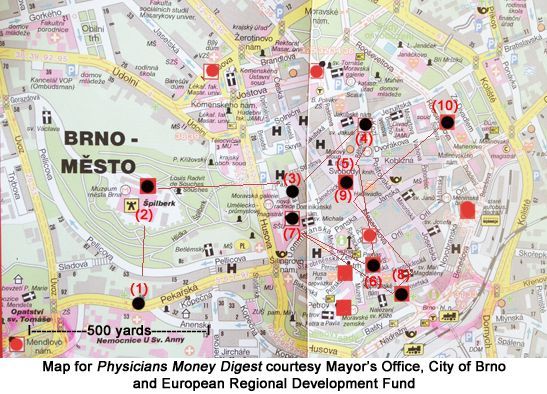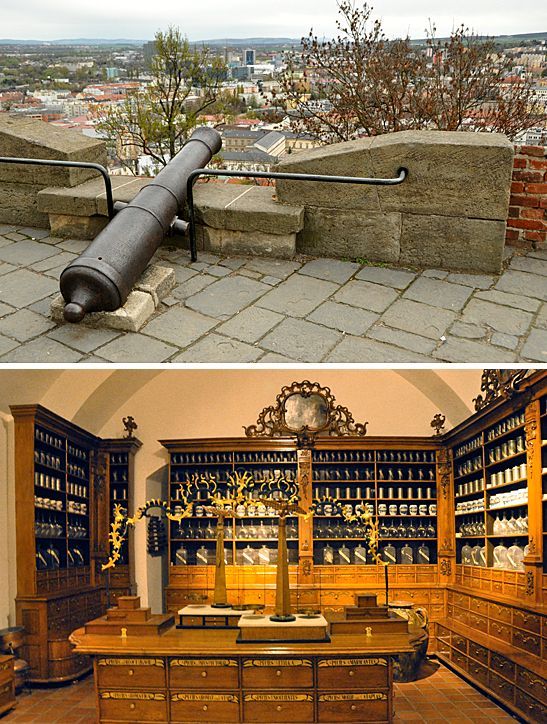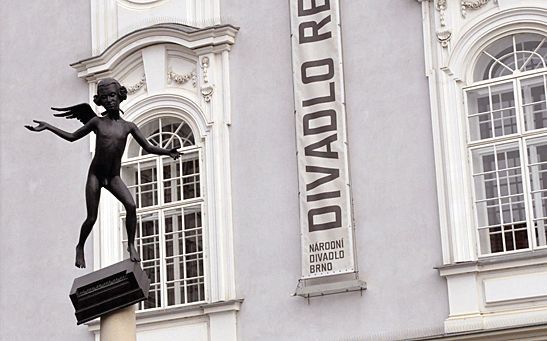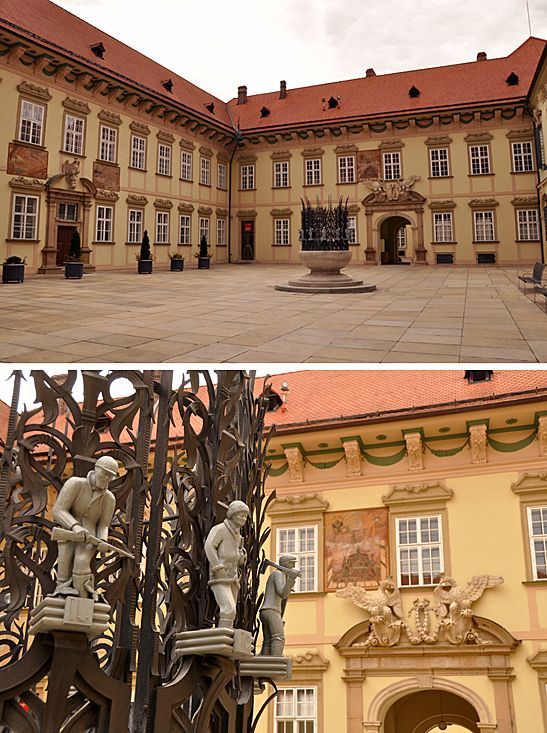Article
A Great Walk Through Brno
Author(s):
Brno, the second largest city in the Czech Republic, may be an enigma to Americans, but it's less expensive, busy and touristy than Prague. And you can walk through its very heart in a single day.
Photography by the authors
Brno, the second largest city in the Czech Republic, may be an enigma to American tourists. Strangely, it hardly does any marketing of itself. Book stores in the United States seldom carry enough information about the one-time capital of Moravia to make Americans think it’s where they might want to go on vacation. More is the pity because it’s really a fascinating town: it’s less expensive than Prague and less busy, less touristy. And you can walk through its very heart in a single day.

“The trouble with Prague is that 90% of the tourists in Prague are in 5% of the city!” says a Brno friend who loves both cities. “I believe famous cities are either extrovert or introvert. Paris, for example, is extrovert. London is introvert.”
“And Brno and Prague?” we ask.
“Well, there’s a saying, ‘Prague and Brno are both provincial cities, but only Brno knows it.’”
Well maybe that’s been said but we are captivated as we walk the city in a day with our guide Don Sparling along the cobblestones. But he warns us Brno doesn’t have many buildings from the Middle Ages. There’s a reason.
“Where you find lovely, intact old cities in Europe, it means one of two things, or both: that at some point in the past the city was lucky enough to escape the wars that swept back and forth across the continent for centuries or it became a backwater, bypassed by progress.”
Brno, like the whole of the Czech Republic, was spared virtually every war after the Thirty Years' War in the first half of the seventeenth century.
“But,” says Don, “in the nineteenth century — unlike, for example, Prague — Brno, as one of the richest and most progressive cities in the Austrian Empire, had its focus on development.”
St. Anne’s University Hospital. It is the International Clinical Research Center (ICRC) and it will be the largest medical research collaboration Mayo Clinic has outside the United States. (Location shown as 1 on our map)
It still has. We walk past a new building going up next to

Such a health facility will surely contrast with Brno’s most popular tourist attraction, Spilberk Castle, which was built as a royal palace in the 13th century then converted centuries later into the Baroque fortress “that was the most feared prison in the Habsburg monarchy.”
The Gestapo found it ideal during World War II when history cruelly repeated itself. (2) An ancient apothecary store has been maintained as a tourist attraction in the castle.
The Czechs have a reputation of being a bit paranoid but Don disputes that.
“This is a small country with a population of only 10 million that has spent centuries under oppression,” he says.
of identity and the fighting to maintain it, the
Czech Republic could
“dissolve in the EU
like
a
sugar cube
in a
cup of coffee” if care isn’t taken.
The current
Vaclav Klaus once said, on the subjectCzech president was once called “the Margaret Thatcher of Central Europe,” and his Euroscepticism surely now is seen as prescient!

Ten minutes after walking past the cannons at the castle we pass a downtown wall of photographs (situated someplace around 3 on map). The photos show young people who were detained by the communists and executed on trumped-up charges. It makes you realize the Hungarian Marxist Georg Lukacs and the famous Czech writer Milan Kundera might have both had a point when they said: “Kafka was a realist!”
Maybe, but we see a lot of tongue-in-cheek humor as we walk Brno’s streets with Don, who was educated at the University of Toronto and Oxford, England, and was the former director of International Studies at Masaryk University, Brno.
We walk past the massive St. James Church (4) and our attention is directed to a carved figure mooning the passersby. Anton Pilgrim created it around 1520, a Late Gothic joke, possibly because the church took its time to pay its builder.
— in a city of antiquity it’s a complicated digital time piece put up in 2010 and shaped like an immense bullet.
A more modern example of Czech humor lying beyond is the Town Clock (5) in Freedom Square

There are, for sure, many statues in town but the tendency of the Czechs not to take themselves too seriously is seen in their statue of Mozart in front of the Reduta Theater. (6) Mozart performed here in 1767 at the age of 11. He is portrayed with a young body but an old face and the wings of an angel.

the fountain with allegorical figures represents the 12 months of the year. Sculptors
designed the fountain in 1928 to celebrate the 10th anniversary of the Czechoslovak Republic. (7)
The New Town Hall is misnamed. Sure it’s more recent than the 1240 Old Town Hall, but only by about 10 years! It’s a former Dominican monastery and within its courtyard
The town hall’s cellar had the medieval workshop where coins were minted. The cellar connects with the labyrinth Brno’s Underground under the Vegetable Market — the new tourist attraction in town.
A pharmacy called The Sign of the Red Cray Fish was built in 1620 on the street now called Masarykova. It’s still there.
— perhaps not — is the Baroque Capuchin crypt (8) built by the architect Grimm. He was not related to the Brothers Grimm, who wrote the scary children’s fairy tales, but the crypt might be creepy enough for a lot of people. Until 1780 the Capuchin order members were laid out here and the bodies became mummified due to the soil composition and air circulation in the church pillars. They still lie here at peace with our world.
Another place perhaps as interesting to physicians
As we walk back to the Grand Hotel, (a great location right beside both the bus and the train station) we pass again through Freedom Square with its tall digital clock, the oldest and biggest square in town. The Brno Council decided to grace the square with memorials to the four “platonic virtues” which are Foresight, Temperance, Justice and Courage. (9)
The first is portrayed by a metal map of the city in 1645 when a general had the foresight to remove the roofs of houses that could be set on fire in an approaching siege. The second virtue is seen in a long tank of cascading water. The third shows a figure in front of the Court House wrestling with its obvious burden.
“Where is Number Four?” we ask our guide, “Where is Courage?”
He coughs and looks at the ground. “The council was given several controversial designs to decide on,” he finally says. “They couldn’t agree. They couldn’t choose. They didn’t have the…,” he hesitates then says “…the courage!”
— the first theater building in all Europe lit entirely by electric light. (10)
Our walk is almost over but there is still time to see the Neo Renaissance Mahen Theater built in 1881-82
Thomas Edison himself came to supervise the work, and a memorial of electrified wire commemorates the event. Inside, looking at the rich velvet drapes and the gilded cherubs it’s easy to be transported back into the Victorian era and the mystique and magnificence of Moravia’s capital.
— but that’s another story.
And as the day ends, we pass the school on Janska Street where Mendel gave his first lecture on genetics in 1865
The Man Who Cried Orange: Stories from a Doctor's Life.
The Andersons, who live in San Diego, are the resident travel & cruise columnists for Physician's Money Digest. Nancy is a former nursing educator, Eric a retired MD. The one-time president of the NH Academy of Family Practice, Eric is the only physician in the Society of American Travel Writers. He has also written five books, the last called




